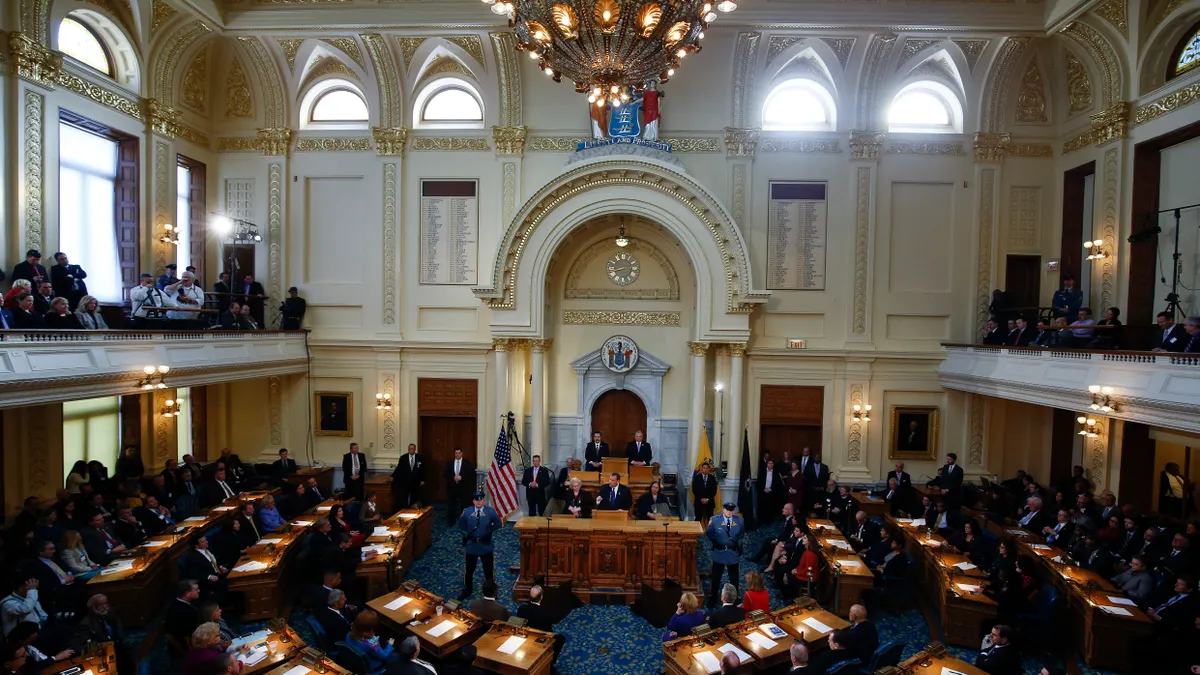More small and mid-sized businesses (SMBs) have been filing for bankruptcy using an expanded subchapter 5 process in an effort to take advantage of its lower costs and more straightforward steps. But this might be the wrong option if you’re not prepared to move quickly, bankruptcy specialist Andrea Hartley told CFO Dive last week.
The process has seen an uptick in use since the federal government last year increased the eligibility threshold to $7.5 million in undisputed debt from $2.7 million as part of the sweeping COVID-19 relief bill called the CARES Act.
By some estimates, about 20% of federal bankruptcy filings use the subchapter 5 process now, and that could pick up if Congress extends the program, which is set to expire at the end of March.
Another year-long extension wasn't included in the COVID relief bill passed by the House last week, but it could be added in when the Senate takes up the bill.
[Editor's note: A one-year extension could be sought in one of the amendments, Hartley says. The COVID-19 Bankruptcy Relief Extension Act of 2021 would provide a one-year extension of temporary bankruptcy provisions in the CARES Act, including the increase of the maximum debt limit for subchapter V from $2.7 million to $7.5 million.]
If Congress doesn't act and the debt-eligibility threshold returns to $2.7 million, the number of companies rushing to file will probably be limited, said Hartley, chair of the bankruptcy practice at the Akerman law firm.
That’s because the subchapter 5 process moves too quickly for many companies to rush into it.
"You really have to have your exit strategy in place, or close to it," she said. "So, if you were contemplating it, you might go ahead and pull the trigger and file, but if you don’t have an exit strategy, you may end up dismissing it."
Faster, cheaper process
The subchapter 5 process can save companies hundreds of thousands of dollars in fees and get them on the path to reorganization quicker because it’s intended for SMB companies without the resources to restructure under the traditional chapter 11 process.
The absence of an unsecured creditors committee is its biggest difference from chapter 11.
"Even in smaller chapter 11 filings, the committee will definitely always have attorneys," she said, "and a lot of the time there will be financial advisors and their own investment bankers, so professional fees can increase exponentially."
These fees are paid out of the bankruptcy estate, so the money ultimately comes out of the debtor company’s bank account.
Another important difference is the 90-day window for submitting the reorganization plan. The window in chapter 11 is 120 days, and extensions, sometimes 18 months long, are common. That long time frame can be costly, because the debtor company must pay ongoing administrative expenses as well as a quarterly federal trustee fee, which can be high.
"Those costs have grown," said Hartley. "They can even be as large as $250,000 a quarter."
Another advantage is the absence of an absolute priority rule, which allows owners to retain equity without having to provide a new value contribution or without having to pay all creditors ahead of themselves. In addition, only the debtor can propose a plan, and does not have to solicit votes, which prevents any one creditor from vetoing the plan and presenting their own as an alternative. Instead, if creditors can’t agree on a plan, it goes to the judge for a decision.
The other important difference is the source of funds from which creditors are paid, which under subchapter 5 is disposable income. That potentially leaves debtor businesses with more money, depending on how they make their case for what’s disposable income.
"Companies could perhaps get creative," she said.
Technically, it’s any income received by the debtor that’s not reasonably expected to be spent on the continuation, preservation or operation of a business, but there’s a lot of potential flexibility in that.
"I anticipate litigation over issues regarding that," she said. "If it’s a small company looking to expand, over the next three to five years, a lot of income could go to expanding operations and buying additional equipment."
Tempting to larger companies
Although the process is intended for SMB companies, large companies are finding ways to use it under the increased debt threshold.
Since the $7.5 million limit only applies to undisputed debt, companies could possibly have much higher debt.
"You could see a company with $30 million in debt disputing $23 million of it to qualify and file," she said. "Of course, a creditor could move to dismiss if they don’t believe they met those requirements."
One restaurant company filed under subchapter 5 by having each of its affiliate restaurants file separately.
"Companies can be creative," she said, although creativity can only take a company so far.
"If you’re 100 employees and $50 million in annual revenue, you’re not what Congress intended for subchapter 5," she said.
Tactical tool
The faster process is not the best tool for companies simply trying to hold off creditors until, say, COVID-19 eases and their business can return to normal.
For these, and other companies hoping to maximize the automatic stay on creditor demands, the longer chapter 11 process might work better, even if it’s costlier. That’s especially the case if the company’s problem isn’t profitability but cash flow, which could apply to many COVID-hit companies expecting to eventually return to profitability.
"We’re seeing a lot of companies that otherwise were doing well and continue to do well but for COVID-19," she said. "So, they may need to file for bankruptcy, not for the typical reason."
The 90-day period for devising a reorganization plan wouldn’t necessarily work to their benefit if their goal is to buy time before they have an approved plan.
"The whole point of filing is to get the automatic stay," she said. "If you park a company in chapter 11, you have to pay the ongoing expenses, but it may be worth it in the end."



















